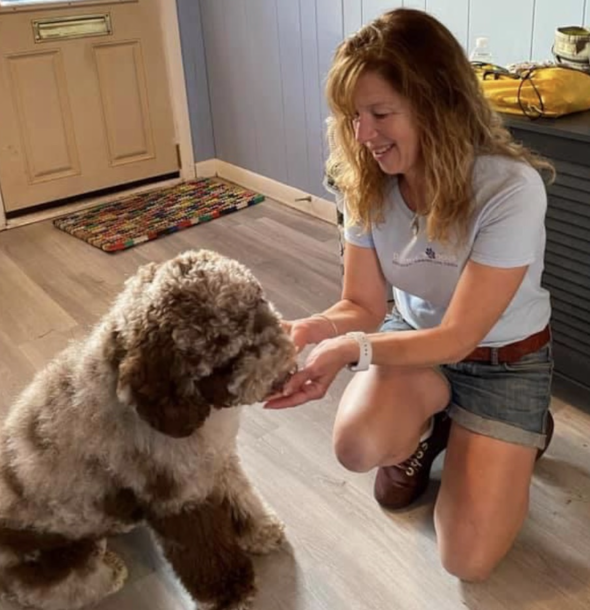Pets and Their People Blog
Fungi Facts for You and Your Four-Legged Loved Ones (Part One)
In this series we will identify and discuss the top ten mushrooms that are poisonous to dogs and what to do if your dog decides to take a bite.
There are few things more rewarding than the wagging tails and happy faces of our dear dogs when stimulating their senses and taking in new information. For the most part, a walk down the street or in the woods with Buddy is a stimulating, enjoyable, and safe experience, however as much as we adore and love to see those curious tails swinging back and forth as our pups sniff away in the grass, it’s important to be aware of the potential dangers that your four-legged loved one may encounter. If ticks and predators weren’t enough, there is another danger lurking, sometimes, in our very own backyards: poisonous mushrooms!
Let’s take a closer look at a few of them here:
Death Cap Mushroom
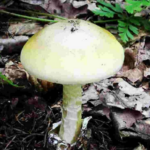
The first mushroom on our list is Amanita phalloides or “death cap.”
- This is one of the deadliest mushrooms to both dogs and humans, containing the toxin, Amanitin, which can cause liver and kidney failure, gastrointestinal issues and can lead to seizures, coma and death.
- Some key features to look out for are a long white stalk with a ring around it and a pale yellow or greenish cap and white gills.
- They can often be found along roots of trees.
- Unfortunately, there is no antidote, so the death rate for ingesting this mushroom is high, hence it’s very telling name.
Fly Agaric
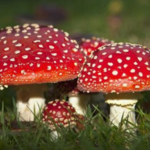
Next up, we have Amanita muscaria or “Fly Agaric.” This mushroom contains ibotenic acid and muscimol, which can cause hallucinations, seizures, and even coma in dogs.
- This mushroom has a bright red cap that is covered in white warts when fully mature.
- Fly agaric will be seen growing from the ground regions of the Northern Hemisphere, typically where coniferous trees grow.
- Though these mushrooms do not pose a threat if eaten by humans, they are known to be frequently eaten by dogs causing sickness or death.
Funeral Bell
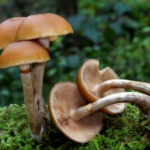
Galerina marginata is also known as funeral bell, deadly skullcap, or autumn skullcap, so it comes as no surprise that this mushroom contains the same poisonous toxins found in death cap, causing the same gastrointestinal symptoms as well as kidney and liver damage or failure.
- This mushroom can be found in Europe, North America and Asia and grows on rotting wood.
- This mushroom is especially tricky because of its similarities in color to edible mushrooms that you might find at the grocery store. Typically, the caps are tan/ light brown to dark brown with a brown stem.
- Identifying this mushroom comes down to finding the often hard-to-see ring around the stem that lies just below the cap.
Brain Mushroom
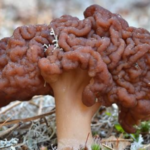
Gyromitra esculenta or false morel or brain mushroom, contains gyromitrin, which can cause seizures, vomiting, and even death in dogs.
- This mushroom is typically found in Europe and throughout North America and grows in sandy soils under coniferous trees.
- These creepy looking fungi can sometimes be mistaken as the edible morel mushroom, hence the name “false morel” and, yep, you guessed it, it resembles a brain, hence the moniker “brain mushroom!”
- Brain mushrooms can range from pink in color to dark brown or even black.
Conocybe
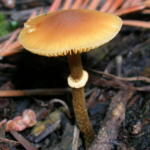
Next on our list we have Conocybe filaris or Conocybe. This mushroom produces alpha-lamantin which is incredibly toxic to the liver and can very easily become deadly in dogs.
- Conocybe is extra tricky, because of the difficulties in identifying it without a microscope.
- This mushroom looks so similar to many other small, brown mushrooms, and tends to grow alone or in clusters, often in patches on lawns or near wood and compost, most commonly in the Pacific Northwest.
- Conocybe reminds us that we can never be too careful, as even the most harmless looking mushrooms can be a threat to our furry friends!
- Keep a look out for a dark reddish/brown cap with a brown stem. The gills will be very apparent, and a paler ring around the stem can help with identification.
If you suspect that your dog has ingested a poisonous mushroom, it’s important to reach out to your vet and/ or poison control for assistance with next steps and potential treatment.
Remember, symptoms of mushroom poisoning can range from mild gastrointestinal upset, to vomiting, diarrhea, lethargy, seizures, and even coma or death. By being vigilant and taking the necessary precautions, you can help keep your dog safe and healthy!
In Part Two of this series, we will discuss more mushrooms that are dangerous to dogs and how to identify them.
REFERENCE:
Shane Hussey, B.S. in Molecular and Cell Biology and B.S. in Ecology and Evolutionary Biology. Shane is the product manager for rare disease at Variantyx Inc., previously a research fellow at UMass Amherst in fungal genetics and former founding president of UConn Mycology Club. He is currently pursuing a Master’s degree in Data Science at Northeastern University.
About the Author
